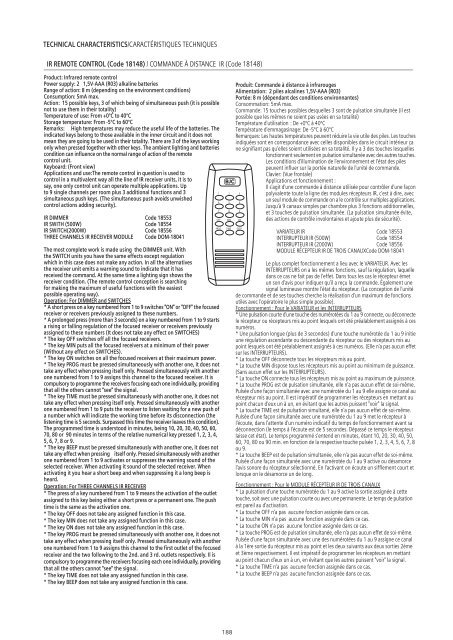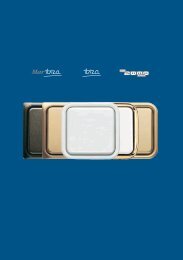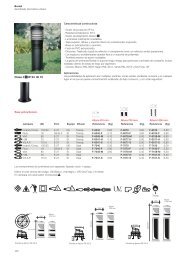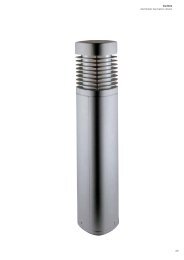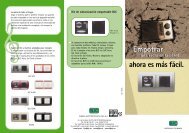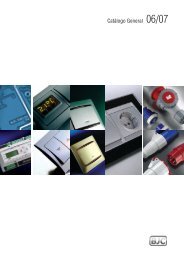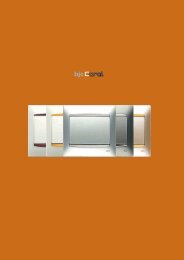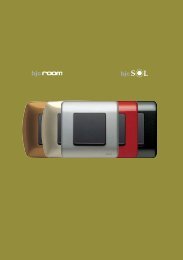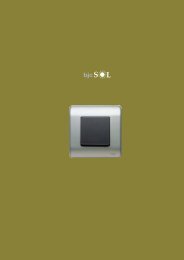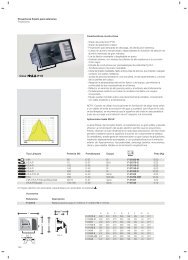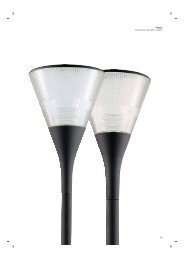Low Voltage Wiring Devices and Installation Material ... - BJC
Low Voltage Wiring Devices and Installation Material ... - BJC
Low Voltage Wiring Devices and Installation Material ... - BJC
Create successful ePaper yourself
Turn your PDF publications into a flip-book with our unique Google optimized e-Paper software.
TECHNICAL CHARACTERISTICS/CARACTÉRISTIQUES TECHNIQUES<br />
IR REMOTE CONTROL (Code 18148) / COMMANDE À DISTANCE IR (Code 18148)<br />
Product: Infrared remote control<br />
Power supply: 2 1,5V-AAA (R03) alkaline batteries<br />
Range of action: 8 m (depending on the environment conditions)<br />
Consumption: 5mA max.<br />
Action: 15 possible keys, 3 of which being of simultaneous push (it is possible<br />
not to use them in their totality)<br />
Temperature of use: From +0ºC to 40ºC<br />
Storage temperature: From -5ºC to 60ºC<br />
Remarks: High temperatures may reduce the useful life of the batteries. The<br />
indicated keys belong to those available in the inner circuit <strong>and</strong> it does not<br />
mean they are going to be used in their totality. There are 3 of the keys working<br />
only when pressed together with other keys. The ambient lighting <strong>and</strong> batteries<br />
condition can influence on the normal range of action of the remote<br />
control unit.<br />
Keyboard: (Front view)<br />
Applications <strong>and</strong> use:The remote control in question is used to<br />
control in a multivalent way all the line of IR receiver units, it is to<br />
say, one only control unit can operate multiple applications. Up<br />
to 9 single channels per room plus 3 additional functions <strong>and</strong> 3<br />
simultaneous push keys. (The simultaneous push avoids unwished<br />
control actions adding security).<br />
IR DIMMER Code 18553<br />
IR SWITH (500W) Code 18554<br />
IR SWITCH(2000W) Code 18556<br />
THREE CHANNELS IR RECEIVER MODULE Code DOM-18041<br />
The most complete work is made using the DIMMER unit. With<br />
the SWITCH units you have the same effects except regulation<br />
which in this case does not make any action. In all the alternatives<br />
the receiver unit emits a warning sound to indicate that it has<br />
received the comm<strong>and</strong>. At the same time a lighting sign shows the<br />
receiver condition. (The remote control conception is searching<br />
for making the maximum of useful functions with the easiest<br />
possible operating way).<br />
Operation: For DIMMER <strong>and</strong> SWITCHES<br />
* A short press on a key numbered from 1 to 9 switches "ON" or "OFF" the focused<br />
receiver or receivers previously assigned to these numbers.<br />
* A prolonged press (more than 3 seconds) on a key numbered from 1 to 9 starts<br />
a rising or falling regulation of the focused receiver or receivers previously<br />
assigned to these numbers (It does not take any effect on SWITCHES)<br />
* The key OFF switches off all the focused receivers.<br />
* The key MIN puts all the focused receivers at a minimum of their power<br />
(Without any effect on SWITCHES).<br />
* The key ON switches on all the focused receivers at their maximum power.<br />
* The key PROG must be pressed simultaneously with another one, it does not<br />
take any effect when pressing itself only. Pressed simultaneously with another<br />
one numbered from 1 to 9 assigns this channel to the focused receiver. It is<br />
compulsory to programme the receivers focusing each one individually, providing<br />
that all the others cannot "see" the signal.<br />
* The key TIME must be pressed simultaneously with another one, it does not<br />
take any effect when pressing itself only. Pressed simultaneously with another<br />
one numbered from 1 to 9 puts the receiver to listen waiting for a new push of<br />
a number which will indicate the working time before its disconnection (the<br />
listening time is 5 seconds. Surpassed this time the receiver leaves this condition).<br />
The programmed time is understood in minutes, being 10, 20, 30, 40, 50, 60,<br />
70, 80 or 90 minutes in terms of the relative numerical key pressed 1, 2, 3, 4,<br />
5, 6, 7, 8 or 9.<br />
* The key BEEP must be pressed simultaneously with another one, it does not<br />
take any effect when pressing itself only. Pressed simultaneously with another<br />
one numbered from 1 to 9 activates or suppresses the warning sound of the<br />
selected receiver. When activating it sound of the selected receiver. When<br />
activating it you hear a short beep <strong>and</strong> when suppressing it a long beep is<br />
heard.<br />
Operation: For THREE CHANNELS IR RECEIVER<br />
* The press of a key numbered from 1 to 9 means the activation of the outlet<br />
assigned to this key being either a short press or a permanent one. The push<br />
time is the same as the activation one.<br />
* The key OFF does not take any assigned function in this case.<br />
* The key MIN does not take any assigned function in this case.<br />
* The key ON does not take any assigned function in this case.<br />
* The key PROG must be pressed simultaneously with another one, it does not<br />
take any effect when pressing itself only. Pressed simultaneously with another<br />
one numbered from 1 to 9 assigns this channel to the first outlet of the focused<br />
receiver <strong>and</strong> the two following to the 2nd. <strong>and</strong> 3 rd. outlets respectively. Il is<br />
compulsory to programme the receivers focusing each one individually, providing<br />
that all the others cannot "see" the signal.<br />
* The key TIME does not take any assigned function in this case.<br />
* The key BEEP does not take any assigned function in this case.<br />
1 2 3<br />
4 5 6<br />
7 8 9<br />
OFF MIN ON<br />
PROG TIME DEEP<br />
Produit: Comm<strong>and</strong>e à distance à infrarouges<br />
Alimentation: 2 piles alcalines 1,5V-AAA (R03)<br />
Portée: 8 m (dépendant des conditions environnantes)<br />
Consommation: 5mA max.<br />
Comm<strong>and</strong>e: 15 touches possibles desquelles 3 sont de pulsation simultanée (il est<br />
possible que les mêmes ne soient pas usées en sa totalité)<br />
Température d'utilisation : De +0ºC à 40ºC<br />
Température d'emmagasinage: De -5ºC à 60ºC<br />
Remarques: Les hautes températures peuvent réduire la vie utile des piles. Les touches<br />
indiquées sont en correspondance avec celles disponibles dans le circuit intérieur ça<br />
ne signifiant pas qu'elles soient utilisées en sa totalité. Il y a 3 des touches lesquelles<br />
fonctionnent seulement en pulsation simultanée avec des autres touches.<br />
Les conditions d'illumination de l'environnement et l'état des piles<br />
peuvent influer sur la portée naturelle de l'unité de comm<strong>and</strong>e.<br />
Clavier: (Vue frontale)<br />
Applications et fonctionnement :<br />
Il s'agit d'une comm<strong>and</strong>e à distance utilisée pour contrôler d'une façon<br />
polyvalente toute la ligne des modules récepteurs IR, c'est à dire, avec<br />
un seul module de comm<strong>and</strong>e on a le contrôle sur multiples applications.<br />
Jusqu'à 9 canaux simples par chambre plus 3 fonctions additionnelles,<br />
et 3 touches de pulsation simultanée. (La pulsation simultanée évite,<br />
des actions de contrôle involontaires et ajoute plus de sécurité).<br />
VARIATEUR IR Code 18553<br />
INTERRUPTEUR IR (500W) Code 18554<br />
INTERRUPTEUR IR (2000W) Code 18556<br />
MODULE RÉCEPTEUR IR DE TROIS CANAUXCode DOM-18041<br />
Le plus complet fonctionnement a lieu avec le VARIATEUR. Avec les<br />
INTERRUPTEURS on a les mêmes fonctions, sauf la régulation, laquelle<br />
dans ce cas ne fait pas de l'effet. Dans tous les cas le récepteur émet<br />
un son d'avis pour indiquer qu'il a reçu la comm<strong>and</strong>e. Également une<br />
signal lumineuse montre l'état du récepteur. (La conception de l'unité<br />
de comm<strong>and</strong>e et de ses touches cherche la réalisation d'un maximum de fonctions<br />
utiles avec l'opératoire le plus simple possible).<br />
Fonctionnement : Pour le VARIATEUR et les INTERRUPTEURS<br />
* Une pulsation courte d'une touche des numérotées du 1 au 9 connecte, ou déconnecte<br />
le récepteur ou récepteurs mis au point lesquels ont été préalablement assignés à ces<br />
numéros.<br />
* Une pulsation longue (plus de 3 secondes) d'une touche numérotée du 1 au 9 initie<br />
une régulation ascendante ou descendante du récepteur ou des récepteurs mis au<br />
point lesquels ont été préalablement assignés à ces numéros. (Elle n'a pas aucun effet<br />
sur les INTERRUPTEURS).<br />
* La touche OFF déconnecte tous les récepteurs mis au point.<br />
* La touche MIN dispose tous les récepteurs mis au point au minimum de puissance.<br />
(Sans aucun effet sur les INTERRUPTEURS).<br />
* La touche ON connecte tous les récepteurs mis au point au maximum de puissance.<br />
* La touche PROG est de pulsation simultanée, elle n'a pas aucun effet de soi-même.<br />
Pulsée d'une façon simultanée avec une numérotée du 1 au 9 elle assigne ce canal au<br />
récepteur mis au point. Il est impératif de programmer les récepteurs en mettant au<br />
point chacun d'eux un à un, en évitant que les autres puissent "voir" la signal.<br />
* La touche TIME est de pulsation simultané, elle n'a pas aucun effet de soi-même.<br />
Pulsée d'une façon simultanée avec une numérotée du 1 au 9 met le récepteur à<br />
l'écoute, dans l'attente d'un numéro indicatif du temps de fonctionnement avant sa<br />
déconnection (le temps à l'écoute est de 5 secondes. Dépassé ce temps le récepteur<br />
laisse cet état). Le temps programmé s'entend en minutes, étant 10, 20, 30, 40, 50,<br />
60, 70, 80 ou 90 min. en fonction de la respective touche pulsée 1, 2, 3, 4, 5, 6, 7, 8<br />
ou 9.<br />
* La touche BEEP est de pulsation simultanée, elle n'a pas aucun effet de soi-même.<br />
Pulsée d'une façon simultanée avec une numérotée du 1 au 9 active ou désamorce<br />
l'avis sonore du récepteur sélectionné. En l'activant on écoute un sifflement court et<br />
lorsque on le désamorce un de long.<br />
Fonctionnement : Pour le MODULE RÉCEPTEUR IR DE TROIS CANAUX<br />
* La pulsation d'une touche numérotée du 1 au 9 active la sortie assignée à cette<br />
touche, soit avec une pulsation courte ou avec une permanente. Le temps de pulsation<br />
est pareil au d'activation.<br />
* La touche OFF n'a pas aucune fonction assignée dans ce cas.<br />
* La touche MIN n'a pas aucune fonction assignée dans ce cas.<br />
* La touche ON n'a pas aucune fonction assignée dans ce cas.<br />
* La touche PROG est de pulsation simultanée, elle n'a pas aucun effet de soi-même.<br />
Pulsée d'une façon simultanée avec une des numérotées du 1 au 9 assigne ce canal<br />
à la 1ère sortie du récepteur mis au point et les deux suivants aux deux sorties 2ème<br />
et 3ème respectivement. Il est impératif de programmer les récepteurs en mettant<br />
au point chacun d'eux un à un, en évitant que les autres puissent "voir" la signal.<br />
* La touche TIME n'a pas aucune fonction assignée dans ce cas.<br />
* La touche BEEP n'a pas aucune fonction assignée dans ce cas.<br />
188


